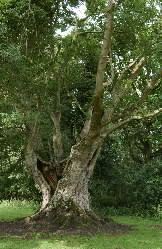 Compared to many historic environment features, veteran/ancient trees are often forgotten parts of our cultural heritage and many are not recorded or actively managed. Many trees are indicators of past land management and use. They vary widely in species and physically take many forms such as coppice, pollard, stubb, maiden or a phoenix regeneration. However, unlike most other heritage features, these trees also have an added ecological value. Veteran trees may support a wide range of faunae and fugal bodies, many of which are only associated with long periods of continuity in their habitat. Britain has more veteran trees than most countries in Europe, and their conservation is of international interest. Veteran trees do not have an even distribution throughout Britain in some areas they can be very sparse. Conversely, in areas of historic parkland, estates, and some Royal Forests, high densities are still found. Many forest districts are now mapping their veteran trees into GIS. Other veteran tree data are also held by organisations such as The Veteran Tree Initiative, TreeFest and others. Whilst the mapping and management of veteran trees is not as comprehensive as archaeological features, there are several organisations holding and collating data and providing management advice (see other sources of information).
Compared to many historic environment features, veteran/ancient trees are often forgotten parts of our cultural heritage and many are not recorded or actively managed. Many trees are indicators of past land management and use. They vary widely in species and physically take many forms such as coppice, pollard, stubb, maiden or a phoenix regeneration. However, unlike most other heritage features, these trees also have an added ecological value. Veteran trees may support a wide range of faunae and fugal bodies, many of which are only associated with long periods of continuity in their habitat. Britain has more veteran trees than most countries in Europe, and their conservation is of international interest. Veteran trees do not have an even distribution throughout Britain in some areas they can be very sparse. Conversely, in areas of historic parkland, estates, and some Royal Forests, high densities are still found. Many forest districts are now mapping their veteran trees into GIS. Other veteran tree data are also held by organisations such as The Veteran Tree Initiative, TreeFest and others. Whilst the mapping and management of veteran trees is not as comprehensive as archaeological features, there are several organisations holding and collating data and providing management advice (see other sources of information).
The term veteran tree is not precisely defined, as various criteria may determine the veteran status of an individual tree when compared to others. For example, a tree may be regarded as a veteran due to great age; great age relative to others of the same species, existing in an ancient stage of life or due to its biological, aesthetic or cultural interest. Size alone is a poor indicator of veteran status, as different species may have different rates of growth or natural life spans. Management practices such as coppicing may also belittle the true age of the coppice stool. For this reason, the species, relative ages, management practice, aesthetic, cultural and biological importance should all be taken into account when surveying or assessing potential veteran trees.